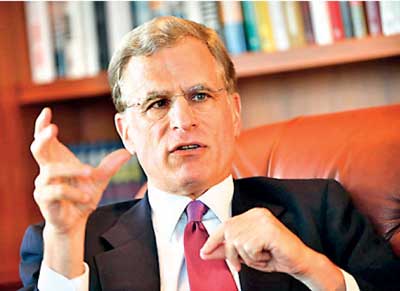Wednesday Feb 12, 2025
Wednesday Feb 12, 2025
Wednesday, 3 August 2016 00:00 - - {{hitsCtrl.values.hits}}

Reuters: A raft of global risks that could adversely affect the United States remain on the horizon and require close monitoring, Dallas Federal Reserve Bank President Robert Kaplan said on Tuesday.
“I am closely monitoring how slowing growth, high levels of overcapacity and high levels of debt to GDP in major economies outside the US might be impacting economic conditions in the US,” Kaplan, a centrist at the US central bank, said in remarks prepared for delivery at an event in Beijing.
In his second appearance within a week, Kaplan repeated that he continues to back tightening monetary policy in a gradual and patient manner.
Kaplan, along with several other Fed policymakers, has urged renewed caution in trying to lift rates again since the US central bank raised its benchmark interest rate for the first time in almost a decade last December.
Chief among his concerns is sluggish US growth exacerbated by a changing world in which economies are more globally interconnected.
Kaplan warned that China’s debt growth “may prove to be unsustainable,” and that as its growth continues to slow the Fed “will continue to carefully monitor the potential spillover effects on currencies as well as global financial conditions.”
The Dallas Fed chief, who is not a voting member on Fed policy this year but participates fully in deliberations, also said he would continue to monitor and assess the implications of Britain’s vote to leave the European Union.
While the so-called Brexit vote has had little initial impact on the US economy, Kaplan said it would take time before its ultimate effects on Britain, Europe and the rest of the world became clear.
Kaplan’s comments make him the second policymaker this week to strike a modestly downbeat note on the Fed’s ability to raise rates soon.
On Monday New York Fed President William Dudley, a permanent voter on the Fed’s rate-setting committee, said that while it was “premature” to rule out a rate increase this year, negative economic shocks were more likely than positive ones.
Investors have curbed bets that the Fed will raise rates again in 2016. They currently see a one in three chance the central bank will raise rates at its December meeting, according to the CME Group.
The Fed still projects two more rate rises by the end of the year but has been stymied since December by a changing backdrop of global uncertainty and periodically disappointing US economic data.
The Fed’s next policy meeting is on 20-21 September.
Discover Kapruka, the leading online shopping platform in Sri Lanka, where you can conveniently send Gifts and Flowers to your loved ones for any event including Valentine ’s Day. Explore a wide range of popular Shopping Categories on Kapruka, including Toys, Groceries, Electronics, Birthday Cakes, Fruits, Chocolates, Flower Bouquets, Clothing, Watches, Lingerie, Gift Sets and Jewellery. Also if you’re interested in selling with Kapruka, Partner Central by Kapruka is the best solution to start with. Moreover, through Kapruka Global Shop, you can also enjoy the convenience of purchasing products from renowned platforms like Amazon and eBay and have them delivered to Sri Lanka.
Discover Kapruka, the leading online shopping platform in Sri Lanka, where you can conveniently send Gifts and Flowers to your loved ones for any event including Valentine ’s Day. Explore a wide range of popular Shopping Categories on Kapruka, including Toys, Groceries, Electronics, Birthday Cakes, Fruits, Chocolates, Flower Bouquets, Clothing, Watches, Lingerie, Gift Sets and Jewellery. Also if you’re interested in selling with Kapruka, Partner Central by Kapruka is the best solution to start with. Moreover, through Kapruka Global Shop, you can also enjoy the convenience of purchasing products from renowned platforms like Amazon and eBay and have them delivered to Sri Lanka.